The Baby, The Bathwater, and Core Vocabulary
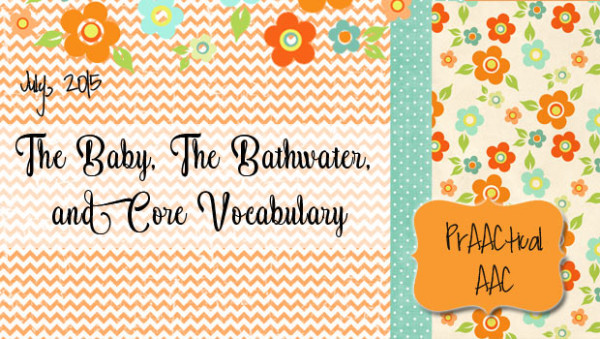
When we first started writing to advocate for core vocabulary, it was as a counterpoint to the noun-heavy, activity-specific AAC supports that were widely used among beginning communicators. Many times, those communication aids were great for getting communication started with our beginning communicators, but limited their ability for generative language development. Adding core vocabulary provided a lot of linguistic power, and for many learners, that’s a great thing. These days, most clinicians serving people with AAC needs are well aware of the need to populate their AAC systems with a sizable array of high-frequency core words. SLPs have, by and large, gotten the message that core vocabulary plays an important role for AAC learners.
In some cases, though, the pendulum has swung a bit too far. An AAC a system built exclusively of single words with only core vocabulary is not likely to meet the needs of most AAC learners. Their systems need to be balanced with three additional elements: fringe vocabulary, prestored phrases/sentences, and alphabet access.
To avoid throwing the baby out with the bathwater, it’s important to realize that adding core words doesn’t mean that we take away or fail to provide access to other kinds of words.
Fringe Vocabulary
It’s not an all-or-nothing proposition. A system that is rich in core vocabulary doesn’t mean we ignore fringe vocabulary. All learners need words that allow them to speak about the things they hold near and dear: the people/pets in their lives, favorite things, places they like to go, etc.
Beginning communicators are a diverse group. Some move through this stage within a year, but others acquire language skills much more slowly. As we all know, AAC is not a one-size-fits-all 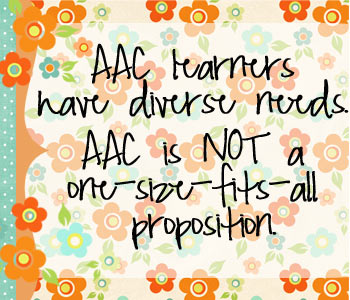 venture. Beginning communicators at the earliest stages of language learning need quite a lot of nouns and verbs, especially for things that are highly meaningful to them. Think: favorite foods, toys, characters, people, places, actions, shows, apps, etc. For many beginning communicators, those are the words that make the most sense to start with. Here’s why.
venture. Beginning communicators at the earliest stages of language learning need quite a lot of nouns and verbs, especially for things that are highly meaningful to them. Think: favorite foods, toys, characters, people, places, actions, shows, apps, etc. For many beginning communicators, those are the words that make the most sense to start with. Here’s why.
- By nature, they are highly motivating, and we all know the critical role that motivation plays in learning new skills. None of us would bother to learn something new unless we saw the value in it, and AAC learners are no different in that respect.
- They can be represented in a more concrete way, something that speeds the learning process. Photographs or AAC symbols for your friends, family, pets, and favorite things are much easier to recognize than symbols for core words. That transparency can be important in the early stages of communication learning.
Prestored Phrases Sentences
For AAC learners to develop generative language, they need AAC systems that have a lot of single words that can be combined in different ways to make sentences. Core vocabulary provides that, but that doesn’t mean that we would restrict the learner to ONLY single words. Prestored phrases and sentences are very important for most people who use AAC, something we wrote about a few years back.
Prestored sentences are shortcuts, and there are two main reasons why having them make sense for most communicators.
- They require less effort. If you want learners to use their AAC system to express themselves, then at least some of it should be easy. Jeremiah, for example, has a core vocabulary system that he uses fairly well to make requests, direct the actions of others, make some basic comments, and respond to questions. He uses core words (along with fringe words) to do this, and while he still needs support, he is getting more competent every week. In social situations, however, Jeremiah really struggles both because his skills are more limited in this area and also because it causes anxiety. Expecting him to build sentences for social conversations is not likely to be successful – it is too hard at this point in time. He will get there, but for now, we can reduce task difficulty by putting together phrases and sentences like these:
-I have something to tell you.
-How are you?
-Tell me about…
-I did something fun with…(mom, Orit, Sammy)
-When will I see you again?
-See you later.
- They are faster to use. Even when someone can competently build sentences with core and fringe vocabulary, it takes awhile for them to select the words and construct their sentences. In some situations, they need to be able to respond more quickly. Having the option of using a prestored sentence to use in those situations makes it more likely that they can respond to the time demands of those situations.
Alphabet Access
AAC learners also need access to the alphabet. Some beginning communicators are already showing interest (and skill) with letters and having access to them on their AAC device supports their literacy learning.
But what about those who don’t yet show interest in letters? Do they need the alphabet, too? Probably. As we said before, this is a diverse group of communicators so there is no single answer that fits all learners at this level. For the most part, though, it’s good to provide them with alphabet access so that we can integrate it into our teaching (when appropriate) and so that they can experiment with letters. Will they ever learn to be literate? There are no guarantees, but having those available certainly makes it more likely. If we want them to eventually learn to read and write, let’s give them access to the alphabet so that we can model and teach, and they can explore and experiment.
Remember, using an AAC system rich in core vocabulary doesn’t mean we ignore the need for fringe words, sentences/questions, or the alphabet. All of these elements can and should work together to help our AAC learners communicate more effectively.
Filed under: PrAACtical Thinking
Tagged With: beginning communicators, core vocabulary, fringe vocabulary, prestored sentences
This post was written by Carole Zangari

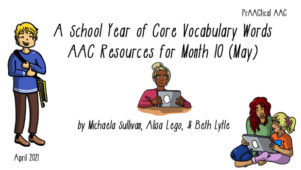
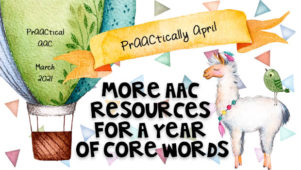
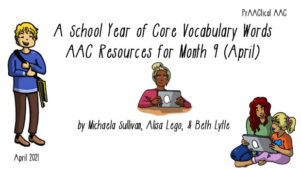
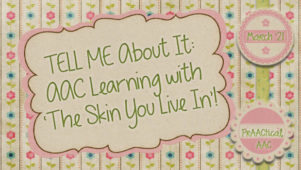
17 Comments
Of all the amazing, wonderful, informative articles you’ve ever posted, this is #1 in my opinion! The title graphic says it all, but then you go on to give such a thorough explanation of the importance of individualizing AAC, using whatever works for each AAC user. There has been such a strong emphasis on core, core, core…so much so that I’ve had SLPs say to me that, even though they felt stored phrases, fringe vocabulary , and situation-specific AAC pages would be most useful to the user, they were “afraid” to use them because they didn’t fit the “core” model. I will definitely be printing multiple copies of this article–a new and valuable addition to my AT portfolio of SETT forms, blank data sheets, and other handouts I carry with me when called to consult for AAC needs. Thank you for this and ALL the incredible work that you do!
Thanks for those words of encouragement, Pat. Truly, I see this problem as a GOOD one. More SLPs are feeling empowered to begin the AAC journey with some of the clients/students on their caseloads despite the fact that they graduated at a time when AAC was not featured very prominently in their pre-service training programs. It takes real courage to bring yourself up to speed on new content areas and then help teams with this kind of intervention. I have so much respect for the clinicians who do this, and am grateful when I have the opportunity to play a small part in their learning process.
Thank you for this article
What a wonderful reflection on the many pieces of the AAC puzzle and how they all work together. This article poingiantly creates a space for each component to exist. I can’t wait to share this!!!
Tabi, so nice of you to take the time to comment. I appreciate your support. 🙂
I simply cannot express in words how much I love this post. Thank you, PrAACtical AAC, thank you Carole. This just became a ‘must read’ post for our students – so beautifully, perfectly put. Thank you!
So glad that you found it helpful, Laura. Thanks so much for sharing it with your students. 🙂
Fabulous Carol – thanks so much! Just perfect 🙂 Can we use the graphic about AAC learners having diverse needs? 🙂
Thanks, Jane. Of course!! 🙂
The point I would take issue with, Carole, is your use of the term “fringe” vocabulary. Since all it means is that a word is not “core”, you are back in categorizing words purely in terms of their frequency – clearly a fairly one-dimensional basis to select an entire vocabulary. In addition I believe the term is intrinsically judgemental, and will frighten uncertain clinicians off (see Pats comment above).
YES!
This is spot on! We are working with our 4.5 year old son, Noah on building vocabulary with the LAMP program and your thoughts have given me so much direction. Thank you, thank you! Truly.
Dr. Zangari – This is exactly what we needed to hear! I’ll be using this article as a supplemental aid during a district training on Environmental Communication Teaching next week. The SLP’s and teachers attending will appreciate the added guidance. Thank you for sharing!
Thank you Dr. Zangari! I will be sharing your article this week with my grad students in my AAC class here in Missoula, Montana. I appreciate your perspective and highly agree!
So glad that this was helpful, Julie!! Good luck with your AAC class. 🙂
Thank you so much for an eye opening article!
Thank you so very much for this article! I work primarily with beginning age communicators and felt that “core” only vocabulary push was not developmentally appropriate for my 2-3 year olds who were still learning basic noun+verb type vocabularies. I love an all inclusive approach as you so eloquently discussed. This article has renewed my excitement to combine “fringe” + core and stored phrases to better help those I serve. Thank you for a wonderful website!
Debbie